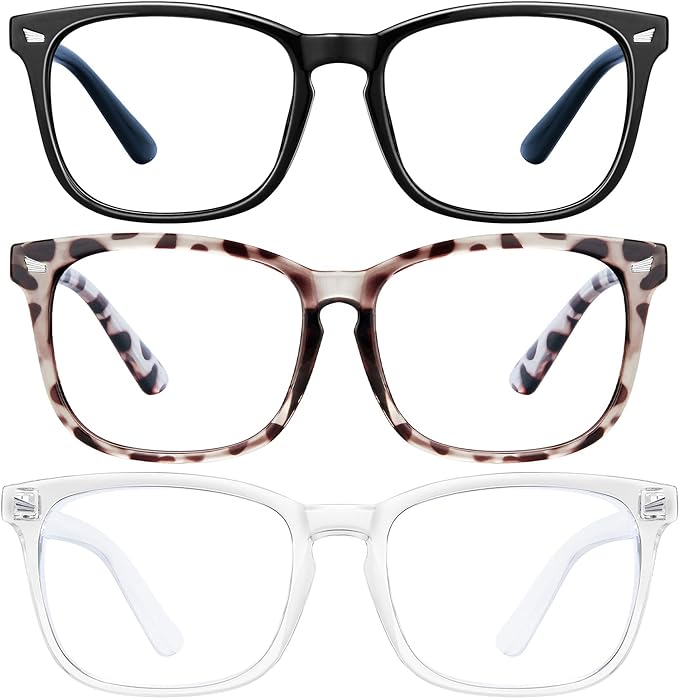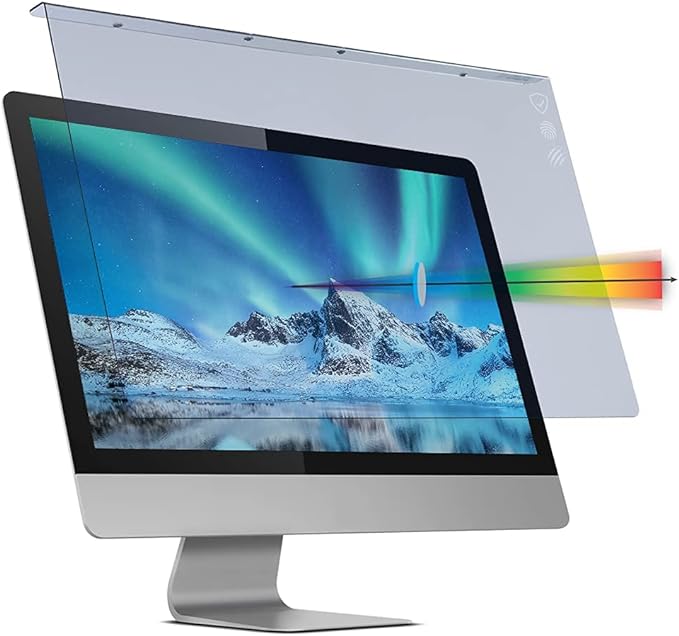Granny was right – watching TV is really bad for the eyes.
We are constantly bathed in the glow of screens and artificial lighting, bringing us face-to-face with a less visible yet significant aspect of our daily lives: blue light. This article takes a closer look at blue light, a topic gaining increasing attention due to our growing reliance on digital devices and modern lighting solutions. While blue light is a natural part of the light spectrum, its omnipresence in our digital lives warrants a closer look at its impact on our eyes and general wellness.
You will also learn insights and strategies to manage blue light exposure effectively. Understanding the nature of blue light, its sources, and how it affects us is crucial for everyone today. This guide will empower you with knowledge and practical tips to protect your eyes and health in an age where blue light is an inescapable part of our environment.
Understanding the Science of Why We Need Blue Light Glasses
This science will help you better understand the necessity for blue light glasses.
The Basics and Impact of Blue Light
Blue light is everywhere. It’s an integral part of the visible light spectrum, characterized by its short wavelength and high energy. The primary natural source of blue light is the sun, according to the Illinois Eye Center. But it’s also prevalently emitted by digital screens, LED lighting, and fluorescent bulbs. Understanding how blue light affects us is key in our technology-rich environment.
Interaction with Eyes: Our eyes are inefficient in filtering out blue light. Unlike UV rays, mostly blocked by the cornea and lens, blue light penetrates through to the retina, the sensitive part of the eye. That has raised concerns about potential long-term damage, including the risk of macular degeneration.
Health Implications: Exposure to blue light, particularly during the evening, can disrupt our circadian rhythm, the body’s natural sleep-wake cycle. This disruption can lead to sleep issues and may contribute to digital eye strain during prolonged exposure. However, blue light isn’t all bad; it can boost alertness and mood during the day.
Everyday Exposure: Daily life in our modern world means more time in front of screens and under artificial lighting. This lifestyle increases our exposure to blue light, making it important to know how we interact with technology and lighting.
Current Perspectives: While concerns about blue light are valid, it’s essential to take in the topic with a balanced view. Blue light is a natural part of our environment, and understanding how to manage exposure is more beneficial than trying to avoid it completely.
Blue Light in Your Daily Life
Here are some facts about blue light exposure and
Everyday Exposure to Blue Light… and Its Consequences
Whether it’s working on a computer, scrolling through our phones, or relaxing in front of the TV, we’re constantly exposed to blue light. This section explores how our typical day-to-day activities contribute to blue light exposure and the importance of managing this in our lives.
Pervasive Screen Use: Digital screens are the most common source of blue light daily. From smartphones to computers and tablets, these devices are integral to our work, communication, and entertainment, making us susceptible to prolonged exposure.
Home Lighting: The shift towards energy-efficient lighting, like LED and fluorescent bulbs, means we’re surrounded by more blue light at home. While beneficial for the environment and energy consumption, these lighting choices add to our daily blue light intake.
Blue Light and an Impact on Health: Increased blue light exposure, especially in the evenings, can interfere with our sleep patterns by disrupting melatonin production, the hormone responsible for sleep. Besides that, prolonged screen time can lead to digital eye strain, according to the doctors at Daniel Island Eye Care. These are characterized by symptoms like dry eyes, headache, and blurred vision.
Importance of Management: Understanding and managing blue light exposure is essential in maintaining good eye health and your wellness, in general. It’s about finding a balance that allows us to enjoy the benefits of modern technology while minimizing potential negative impacts.
Strategies for Protecting Your Eyes, Besides Blue Light Glasses
Here’s the good news – you can protect your eyes. Blue light glasses are one means of protecting them. But you can also try these strategies to protect your eyes from blue light.
Screen Filters and Glasses:
- Blue Light Glasses: Specially designed blue light-blocking glasses that filter out blue light. You will find many colors and styles. They can be a stylish and effective way to protect your eyes during screen time.
- Screen Filters: Adding physical filters to your device screens or using built-in software options that adjust the light emitted can significantly reduce blue light exposure.
Adjusting Home Lighting:
- Warmer Light Bulbs: Opting for bulbs with a warmer color temperature can help reduce blue light in your home environment.
- Smart Lighting Solutions: Smart lighting systems that allow brightness and color temperature adjustment can help align artificial lighting with natural circadian rhythms.
Device Usage Guidelines:
- Screen Time Limits: Being mindful of the time spent on screens, particularly before bedtime, is crucial.
- Regular Breaks: Adhering to the 20-20-20 rule (every 20 minutes, look at something that sits 20 feet away for 20 seconds). This quick eye exercise can help alleviate eye strain.
Room Setup and Environment:
- Maximizing Natural Light: Utilize natural light daily to reduce reliance on artificial sources.
- Ergonomic Screen Placement: Position screens to minimize glare and ensure they’re not the only light source in the room.
Digital Well-being Features:
- Night Mode on Devices: Using ‘night mode’ settings can reduce blue light emission, particularly in the evenings.
- Customizable Display Settings: Adjust the display settings on your devices to comfortable levels, reducing eye strain.
Technological Solutions and Tools
Technology offers a range of solutions that address the challenges posed by blue light. This section highlights the tools and applications designed to manage blue light exposure, making our interactions with technology healthier for our eyes.
Screen Dimming Applications on Devices (instead of blue light glasses!)
- Function and Use: These applications adjust the screen’s brightness according to the time of day, reducing blue light emission in the evening. This app aligns screen use with the body’s natural sleep-wake cycle.
- Popular Options: Apps like f.lux or the Night Shift feature on Apple devices automatically modify the display’s color temperature to reduce eye strain.
Blue Light Filters for Screens (another alternative to blue light glasses)
- Physical Filters: Transparent films that can be placed over screens to filter out blue light, minimizing its impact on the eyes.
- Inbuilt Software Features: Many devices now have settings to reduce blue light emission. Many have adjustments to suit individual needs and preferences.
Smart Lighting for Homes:
- Adaptive Lighting Systems: Smart bulbs and systems can be programmed to change their color temperature throughout the day, emitting less blue light in the evenings.
- Control and Convenience: These systems often allow remote control via smartphones or voice commands, making creating a conducive environment for eye health easier.
Selecting the right technology should be based on individual lifestyles and preferences. Ensuring these tools are user-friendly and integrate seamlessly into daily routines is key.

hunsquer Blue Light Glasses for Women/Men Computer Blue Light Glasses
Product Features
Filter Blue light Glasses for Women/Men
Reduce Eyestrain
Lightweight & Durable
Polycarbonate Hd Lens
Best Service & Risk Free Shopping

Universal Blue Light Blocking Screen Protector Panel for 23, 23.6, 23.8, 24 inch Diagonal LED PC Monitor Anti-UV Eye Protection Filter Film – Widescreen Monitor Frame
Product Features
Reduces Eye Strain
Blocks Blue Light & UV Light
Universally Compatible with all 23″-24″ (23″, 23.6″, 23.8″, 24″) Protects Your Monitor from Scratches
Easy To Install
Lifetime Replacement Guarantee
Lifestyle Adjustments for Better Eye Health
Balancing technology with lifestyle changes can create a comprehensive approach to managing blue light exposure. Here are some lifestyle adjustments that can enhance eye health and complement the technological strategies discussed earlier.
Diet and Nutrition for Eye Health:
- Nutrients for Eye Health: Incorporate foods rich in antioxidants. These eye-healthy vitamins include A, C, and E, and essential minerals like zinc. These nutrients, found in leafy greens, fish, and nuts, are beneficial for maintaining eye health.
- Hydration: Consistently staying hydrated helps maintain eye moisture, essential for eye comfort and health.
Sleep Hygiene:
- Consistent Sleep Patterns: Having a regular sleep schedule aids in regulating the body’s circadian rhythm, countering the disruptive impacts of blue light on your sleep.
- Bedroom Environment: Make your sleeping area conducive to rest. Use dark curtains to block external light and invest in comfortable bedding for improved sleep quality.
Exercise and Better Eye Health:
- Regular Physical Activity: Exercise improves blood circulation. In turn, it improves eye health. Activities like walking, yoga, or stretching are good options.
- Eye Exercises: Simple exercises, like periodically focusing on distant objects, can alleviate eye strain. That’s especially helpful to do after long periods of screen use.
Routine Eye Care:
- Regular Eye Check-ups: Annual visits to an eye care professional are crucial for monitoring eye health and addressing any issues early on.
- Stay Informed: Keeping on top of the latest research on blue light and eye health can provide valuable insights into effective eye care practices.
By incorporating these lifestyle changes, you can better protect your eyes from the effects of blue light, enhancing your overall well-being in today’s technology-centric world.
The Takeaway: Blue Light Glasses Are One of Several Tools to Protect Your Vision
Effectively managing blue light exposure in our technology-driven world requires a multifaceted approach. By combining practical strategies like screen filters and adjusting home lighting with technological tools like dimming apps and smart lighting systems, we can significantly mitigate the impact of blue light.
Complementing these with lifestyle adjustments, including a nutritious diet, regular exercise, and proper sleep hygiene, further enhances our ability to protect our eyes.
These strategies assist in maintaining eye health and overall well-being in our increasingly digital lives. Let’s be proactive and take these simple yet effective steps towards a healthier, blue light managed lifestyle.

